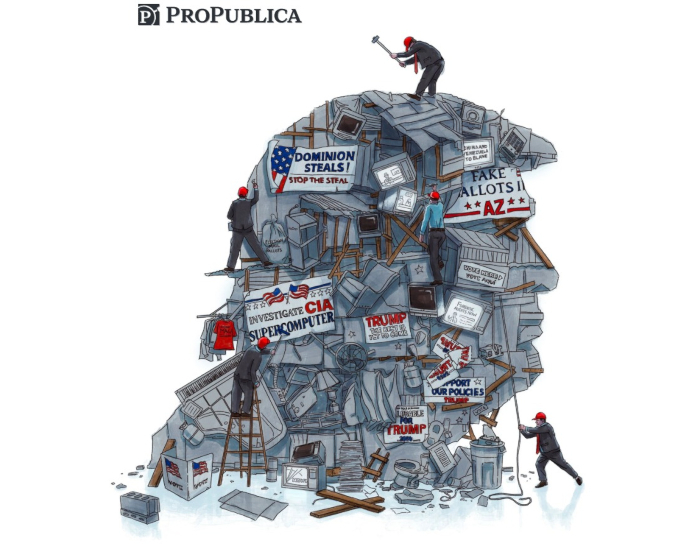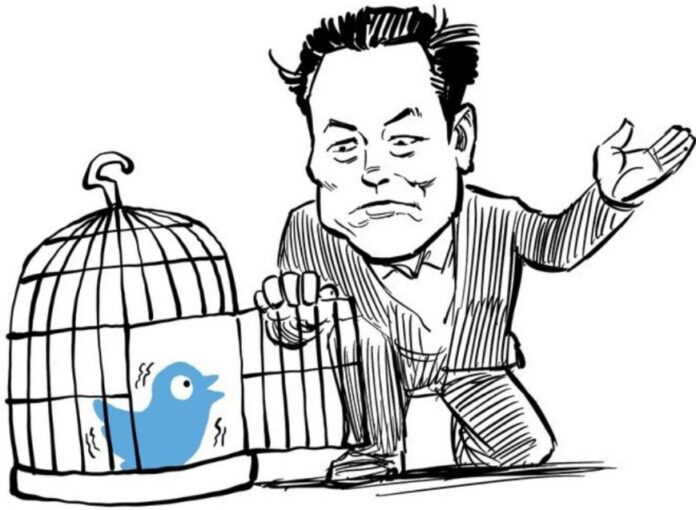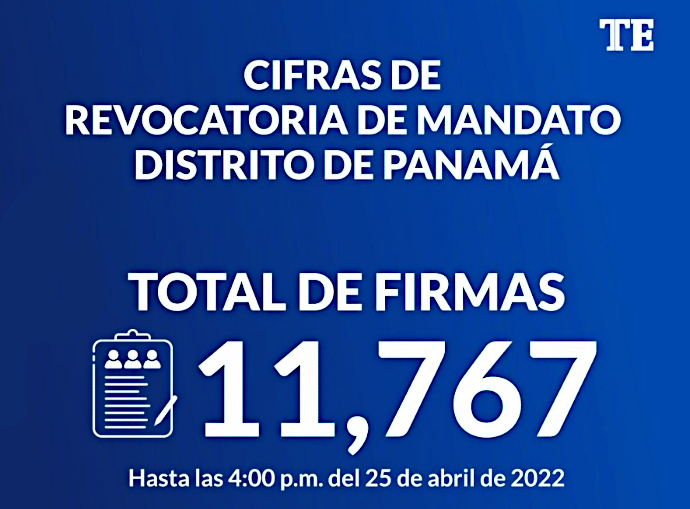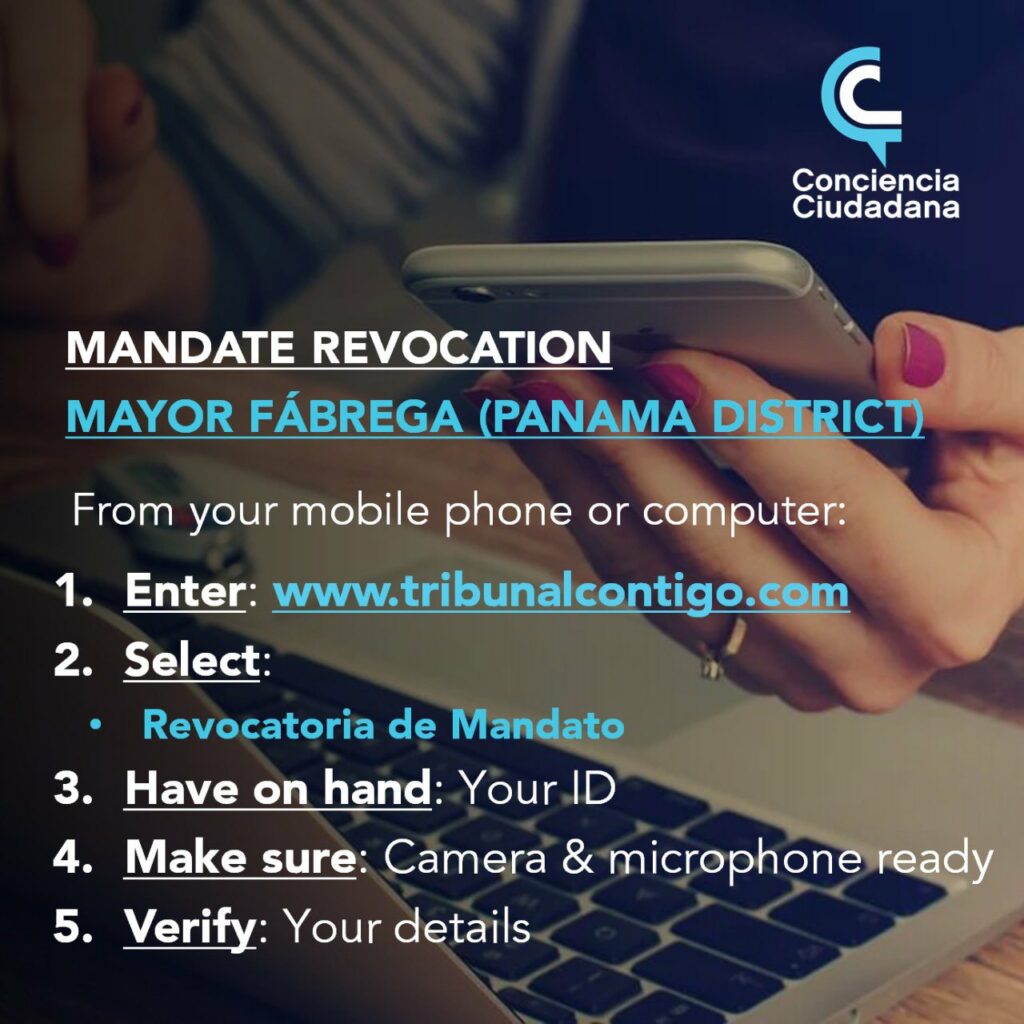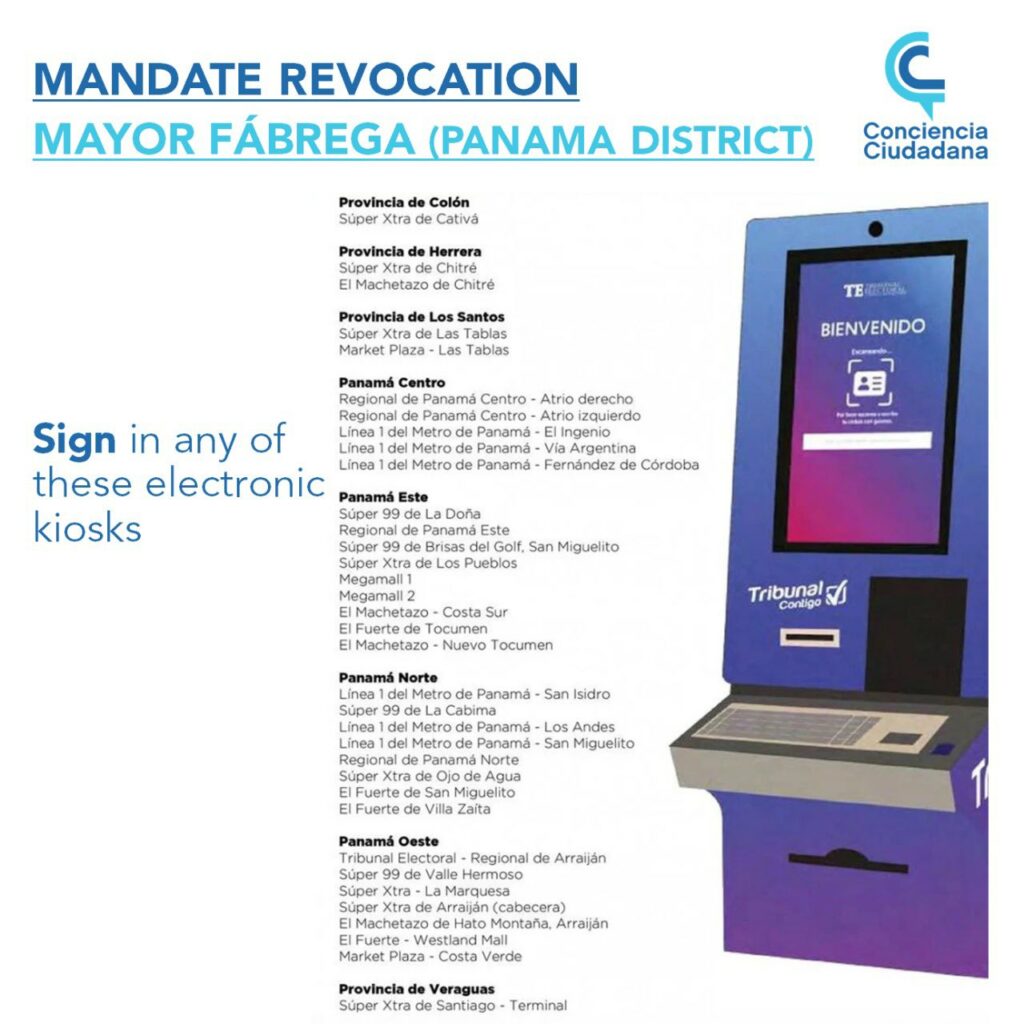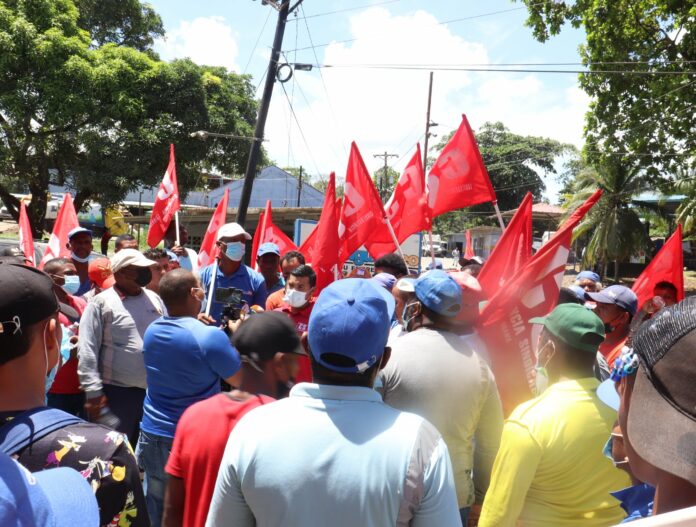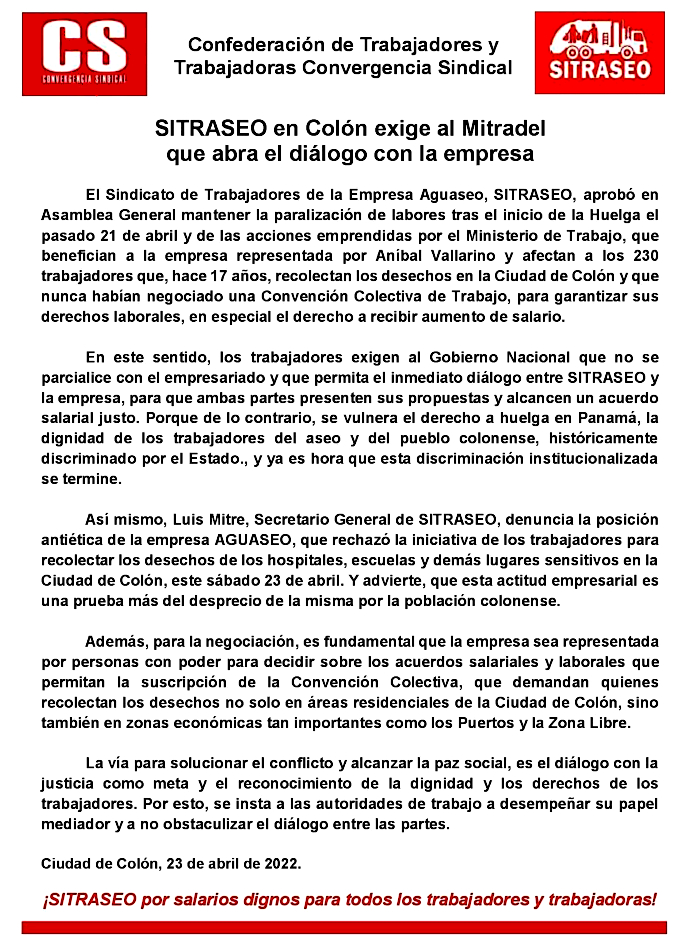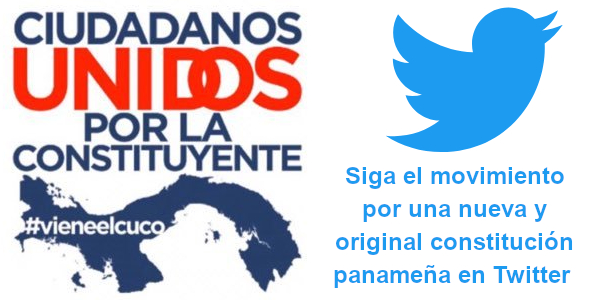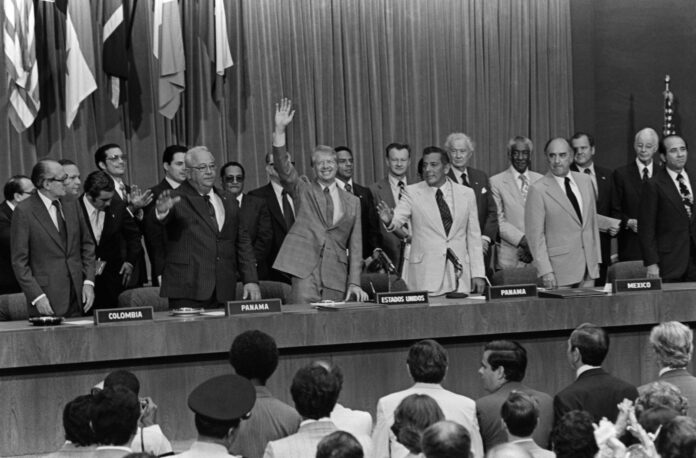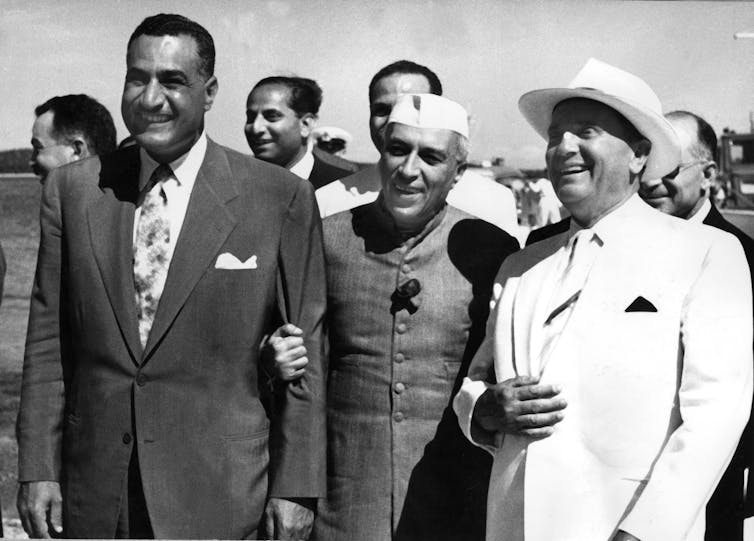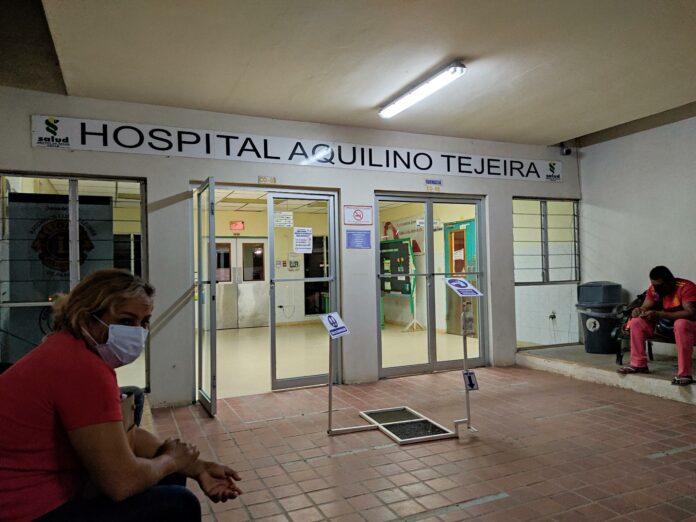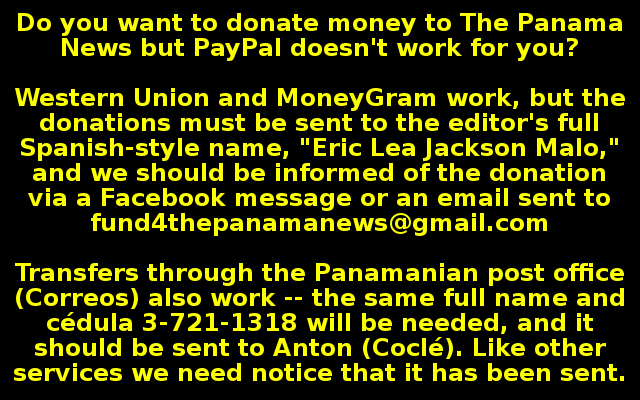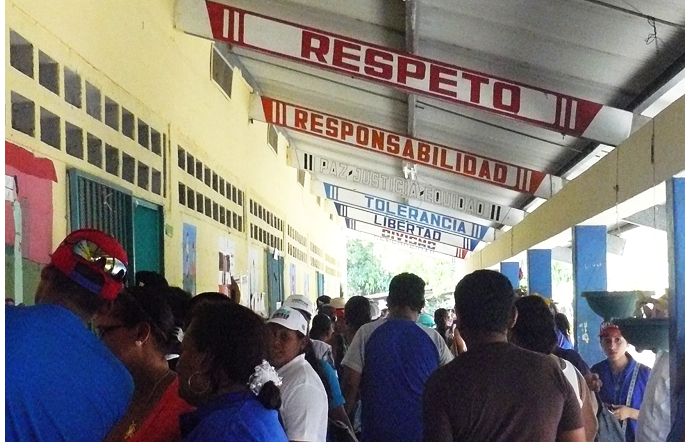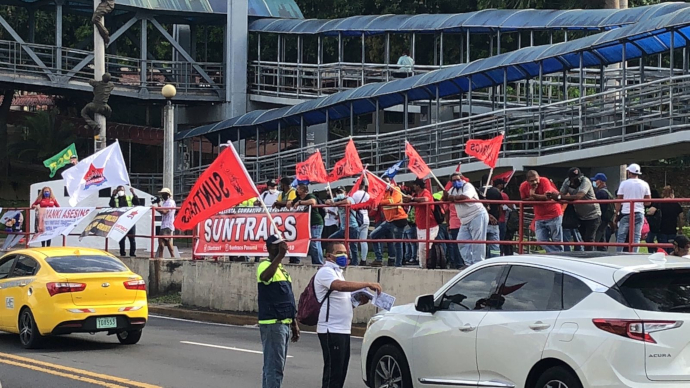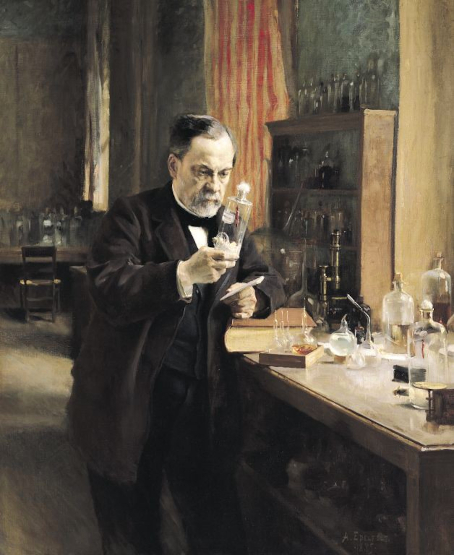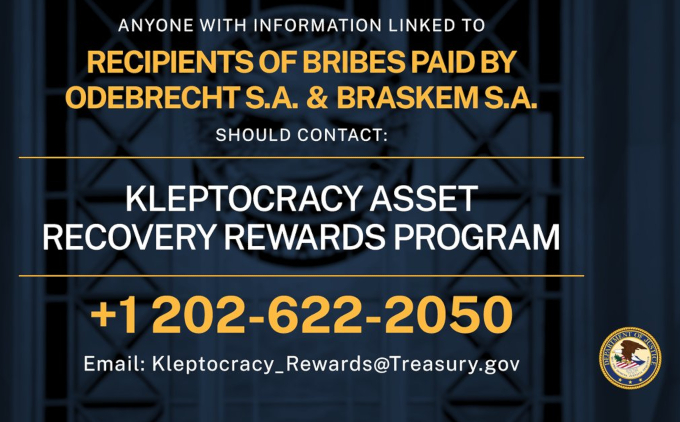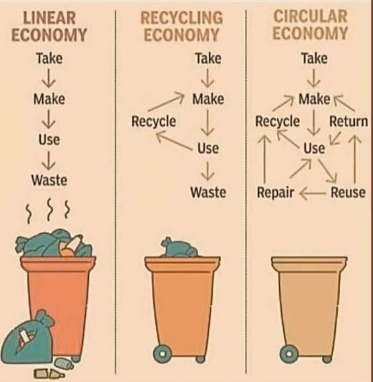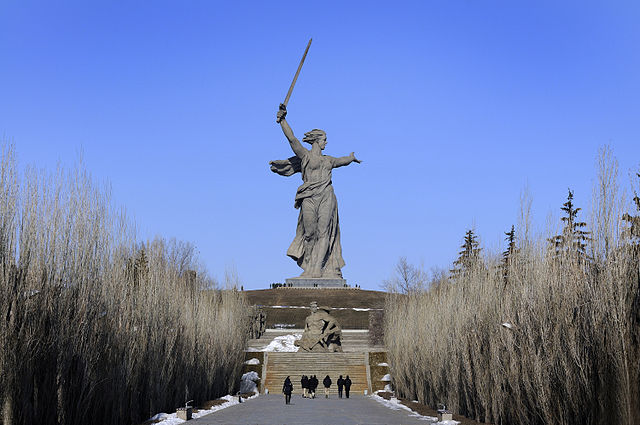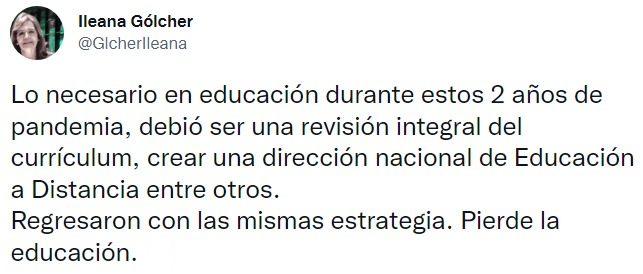Illustration by Leland Foster for ProPublica.
Building the “Big Lie” — Inside the
creation of Trump’s stolen election myth
by Doug Bock Clark, Alexandra Berzon and Kirsten Berg — ProPublica
ProPublica is a Pulitzer Prize-winning investigative newsroom. Sign up for The Big Story newsletter to receive stories like this one in your inbox.
By the time Leamsy Salazar sat down in front of a video recorder in a lawyer’s office in Dallas, he had grown accustomed to divulging state secrets. After swearing to tell nothing but the truth so help him God, he recounted that he was born in Venezuela in 1974, enlisted in the army and rose through its special operations ranks. He described how in 2007 he became the chief of security for Hugo Chávez, the Venezuelan leader whose electoral victories had been challenged by outside observers and opposition parties. After Chávez died in 2013, Salazar said he provided intelligence on top Venezuelan officials involved in drug trafficking to American law enforcement agencies, which had helped him defect.
After about 45 minutes of Salazar telling his life story, the lawyer questioning him, Lewis Sessions, abruptly changed the course of the conversation. “I want to take a moment to get off the track,” said Sessions, the brother of Republican Rep. Pete Sessions of Texas. “Why are you here? What has motivated you to come forward?”
“I feel that the world should know — they should know the truth,” Salazar answered. “The truth about the corruption. About the manipulation. About the lies.”
“The truth about what?” Sessions asked.
“In this case, it’s the manipulation of votes,” Salazar said. “And the lies being told to a country.”
That morning of Nov. 13, 2020, Salazar had a new sort of intelligence to share. He claimed to know that the 2020 US presidential election had been rigged — and how.
Speaking through an interpreter, Salazar said that when he worked for Chávez, he had attended meetings in which the administration discussed how to develop specialized software to steal elections with representatives from Smartmatic, a voting technology company whose founders had ties to Venezuela. He recalled that during the 2013 presidential election, in a secret counting center in Caracas, the capital, he saw officials use software to change votes in favor of Chávez’s successor, Nicolás Maduro, after the polls closed. Watching the 2020 American election, he said, he noticed votes for Joe Biden jumping in a pattern that he thought was similar.
When Sessions asked if Salazar could draw a connection between the events in Venezuela and the recent American election, Salazar replied, “I can show the similarity.” In the 2020 election, Smartmatic machines were only used in Los Angeles, but Salazar explained away this discrepancy. He claimed that the company’s software had been “purchased” by Dominion Voting Systems, whose machines were used in such battleground states as Arizona, Georgia, Michigan, Pennsylvania and Wisconsin — all of which had gone to Biden, sealing his victory over Donald Trump.
Salazar said in a subsequent court filing that he had taken his concerns about the election to “a number of reliable and intelligent ex-co-workers of mine that are still informants and work with the intelligence community.” (He did not specify whether he meant the US or Venezuelan intelligence community.) From there, sources told ProPublica, his concerns reached a former intelligence officer active in Republican politics and then the conservative lawyer Sidney Powell.
Powell was on the hunt for just such information.
By the second week of November, it had become known in right-wing circles that she was working behind the scenes with the president’s legal team to challenge the results of the election. In an email to ProPublica, Sessions wrote that he “conducted the interview at the request of a person working with Sidney Powell’s legal team.” The day after the interview, Trump made Powell’s position official with an announcement on Twitter.
The following morning, Powell traveled to South Carolina, where a loose coalition of lawyers, cybersecurity experts and former military intelligence officers were gathering on a plantation owned by the defamation lawyer Lin Wood to search for evidence of election fraud. One person present at the plantation said that Wood and Powell treated the Salazar video “like the holy grail of evidence.” (In an email to ProPublica, Wood wrote that he was not part of any coalition and that he had only seen “a few minutes” of the video, in which he had “no interest beyond general curiosity.” Powell did not respond to requests for comment.)
There was just one problem. Salazar’s claims were easily disprovable. Hours after the video was recorded, Trump campaign staffers reviewed some allegations about Dominion that were almost identical, and it took them less than a day to discover they were baseless. The staffers prepared an internal memo with section headings that read: “Dominion Has No Company Ties To Venezuela,” “Dominion And Smartmatic Terminated Their Contract In 2012” and “There Is No Evidence That Dominion Used Smartmatic’s Software In The 2020 Election Cycle.” Independent fact-checkers came to the same conclusions. Dominion later released a statement calling a version of these allegations that Powell pushed in a lawsuit, “baseless, senseless, physically impossible, and unsupported by any evidence whatsoever.” A lawyer for Smartmatic wrote to ProPublica: “There are no ties between Dominion Voting Systems and Smartmatic — plain and simple.” He added that “Salazar’s testimony is full of inaccuracies,” strongly denied that Smartmatic’s technology was designed to steal Venezuelan elections, and said the company, which operates worldwide, has “registered and counted over 5 billion votes without a single security breach.” (Salazar did not respond to requests for comment.)
Salazar’s story was just one of many pieces of so-called evidence that members of the coalition have offered as proof that the 2020 election was rigged. That unfounded belief has emerged as one of the most potent forces in American politics. Numerous polls show that over two-thirds of Republicans doubt the legitimacy of the 2020 election. Millions of those Republicans believe foreign governments reprogrammed American voting machines.
ProPublica has obtained a trove of internal emails and other documentation that, taken together, tell the inside story of a group of people who propagated a number of the most pervasive theories about how the election was stolen, especially that voting machines were to blame, and helped move them from the far-right fringe to the center of the Republican Party.
Those records, as well as interviews with key participants, show for the first time the extent to which leading advocates of the stolen-election theory touted evidence that they knew to be disproven or that had been credibly disputed or dismissed as dubious by operatives within their own camp. Some members of the coalition presented this mix of unreliable witnesses, unconfirmed rumor and suspect analyses as fact in published reports, talking points and court documents. In several cases, their assertions became the basis for Trump’s claims that the election had been rigged.
Our examination of their actions from the 2020 election to the present day reveals a pattern. Many members of the coalition would advance a theory based on evidence that was never vetted or that they’d been told was flawed; then, when the theory was debunked, they’d move on to the next alternative and then the next.
The coalition includes several figures who have attracted national attention. Retired Army Lt. Gen. Michael T. Flynn, who served briefly as national security adviser to Trump before pleading guilty to lying to law enforcement about his contacts with Russian officials, is the most well known. Patrick Byrne, the former CEO of Overstock.com who left his position after his romantic relationship with the convicted Russian agent Maria Butina became public, is the coalition’s chief financier and a frequent intermediary with the press. Powell, who represented Flynn in his attempt to reverse his guilty plea, spearheaded efforts in the courts.
Before Powell arrived at the plantation, Wood had filed a lawsuit in federal court in Atlanta against Georgia Secretary of State Brad Raffensperger that sought to stop him from certifying Biden’s victory. Soon after Powell showed up, Wood submitted an anonymized declaration from Salazar as evidence of how the election was corrupted. He then filed an emergency motion that sought access to Dominion machines in Georgia to “conduct a forensic inspection of this equipment and the data therein.” The case was eventually dismissed, but it would serve as a template for the series of high-profile lawsuits that Powell would file in Arizona, Michigan, Wisconsin and Georgia.
Salazar’s declaration was central to the four lawsuits, and it went further than the assertions he had made in the video. His claim that he could show “the similarity” between anomalies in Venezuelan and American elections expanded to become an allegation that “the DNA of every vote tabulating company’s software and system” in the United States was potentially compromised.
Wood told ProPublica, “I was not involved in the vetting, drafting or filing any of the lawsuits filed by Sidney Powell,” though his name appears as “of counsel” in all four. A judge sanctioned him in the Michigan case, writing that “while Wood now seeks to distance himself from this litigation to avoid sanctions, the Court concludes that he was aware of this lawsuit when it was filed, was aware that he was identified as co-counsel for Plaintiffs, and as a result, shares the responsibility with the other lawyers for any sanctionable conduct.”
All the lawsuits would fail, with judges excoriating the quality of their evidence. It wasn’t just the evidence in the lawsuits that was flawed. In fact, much of the evidence that members of the coalition contributed to the stolen election myth outside the courts was also weak. Yet the coalition’s failure to prove its theories has not hindered its ability to spread them.
This is the story of how little untruths added up to the “big lie.”
When Powell and Rudy Giuliani, who was leading the Trump campaign’s legal team in challenging the vote, began investigating election fraud in November 2020, they quickly were inundated with tips. This flood increased once Wood and others began soliciting evidence on far-right message boards and mainstream social media platforms.
Some of the participants at the plantation described the inundation of claims, which overwhelmed their inboxes, as a type of evidence in itself: There must be something to allegations of election fraud if so many people were making them. ProPublica spoke to eight sources with firsthand knowledge of the coalition’s efforts on the plantation, many of whom said they worked relentlessly in a chaotic environment. Tips that easily could have been dismissed as dubious instead were treated as credible.
In examining hundreds of emails sent to the plantation, ProPublica found that some were hearsay or anecdotes seemingly misinterpreting everyday events; others were internet rumors; and many were recycled narratives that some members of the coalition had pushed on social media. None of the tips that ProPublica examined provided concrete proof of election fraud or manipulation.
One of the first tips Powell and Giuliani promoted came from Joe Oltmann, a Denver-based conservative podcast host who said he had infiltrated an antifa conference call and had heard a high-level Dominion employee named Eric Coomer declare that he would make sure that Trump lost the election. Powell and Giuliani highlighted Oltmann’s claim at a press conference on Nov. 19, 2020, at the Republican National Committee headquarters.
By that time, Powell was paying for an investigator to travel to Denver, according to a person familiar with the events. The investigator, the source said, interviewed Oltmann at a brewery in Castle Rock, Colorado, and spent several days checking out his story. Not long after the press conference, according to the source, the investigator emailed Powell his assessment that Oltmann was at the very least embellishing, but she did not respond. Powell soon referred to Oltmann’s allegations in court filings in Georgia and Michigan; roughly a week later, she submitted an affidavit from Oltmann in the Arizona and Wisconsin lawsuits. Coomer has denied being on the call and has brought a defamation suit against Oltmann, Powell, Giuliani, the Trump campaign and others. Oltmann has never presented proof of Coomer being on the call, and in March 2022, the judge overseeing the defamation case sanctioned Oltmann, fining him almost $33,000 for failing to appear for a deposition. When Powell was asked in a July 2021 deposition if she had anyone look into Oltmann and “his background,” she said she did not recall. (Oltmann did not provide responses to questions about the investigator’s assessment.)
Within days of the investigator’s Oltmann probe, Powell turned to another dubious witness: Terpsehore Maras, a QAnon-promoting social media influencer and podcaster who goes by the online handle Tore Says.
In September 2020, in a civil consumer-fraud judgment in North Dakota, Maras had been found to have made false online charitable fundraising solicitations and to have created “an entirely fake online persona.” (Maras has claimed that the allegations against her remain “unproven” despite the legal finding and that “false identities were imperative for me to execute my duties,” which include being a “former private intelligence contractor, whistleblower, and investigative journalist.”)
Powell filed a declaration in early December 2020 from an anonymous individual in the Arizona and Wisconsin lawsuits. The individual claimed that there was “unambiguous evidence” that “foreign interference is present in the 2020 election” and pointed to a vast and unproven conspiracy that involved Dominion, George Soros, a company with an office in China, and the Clinton, George W. Bush, and Obama administrations. The Washington Post later identified the declaration’s author to be Maras.
In the weeks after the election, Maras presented herself to Byrne as knowledgeable about election fraud. But he discovered that she was unreliable after he had a team of investigators debrief her. Byrne and Maras said the debriefing occurred after Powell filed the declaration.
In an email to another witness he had debriefed, Byrne described the investigators’ assessment: “Tore was taken out and interviewed by some people I know from the intelligence community who are absolutely on our side. They came back telling me: ‘She knows some things and has been behind the curtain, but she also lies, exaggerates, deflects, changes subject rapidly trying to throw people off, and we cannot rely on her for anything factual because we caught her in too many lies and exaggerations over three hours.’” (“I tried my best to deceive” the debriefers, Maras wrote on her blog in response to questions from ProPublica. “I was scared.”)
Byrne has since repeatedly promoted Maras’ right-wing activism, as he does in this September 2021 video, some of which revolves around questioning the legitimacy of the election. (“She’s a friend and an ally, and I know that she’s a little goofy,” Byrne told ProPublica in an interview, explaining that he had recently been impressed by work she had done on their shared causes. “I think she has relevant knowledge.”)
Byrne, Powell and other coalition members weren’t just relying on witness statements in their effort to prove the election was rigged. Some of them also pointed to multiple mathematical analyses. One that Powell and Byrne advanced came from a man named Edward Solomon. In the weeks after Nov. 3, 2020, Solomon produced a series of online videos purporting to demonstrate how algorithms adjusted the vote total in Biden’s favor.
Before Byrne and Powell highlighted Solomon’s voting analysis, he came to public attention briefly in 2016, after authorities seized 240 bags of heroin, 25 grams of cocaine and weapons from his home; he later pleaded guilty to selling drugs. (Solomon did not respond to requests for comment.)
One person who coalition members entrusted to vet Solomon’s analysis was Seth Keshel, a former Army intelligence officer who was brought into the group by Flynn and who acknowledged to ProPublica that his mathematical expertise drew from “a long track record of baseball statistics.” In the end, his level of expertise didn’t matter; because of a server error, the emailed request to vet Solomon never reached Keshel, who said he had no memory of checking Solomon’s claims.
Byrne used Solomon’s analysis in his book, “The Deep Rig,” to make the case that the election was fraudulent. In February 2021, a month after the book was published, the University of Pennsylvania’s FactCheck.org reported that officials at the college Solomon had attended said that, though he had been a math major, he had never received a degree. The article quoted experts who pointed to flaws in Solomon’s analysis, especially that the “vote shares” he suggested were suspicious were “not at all surprising,” and a Georgia elections official who said that Solomon “shows a basic misunderstanding of how vote counts work.”
A paper posted that month by University of Chicago and Stanford researchers found that the numbers Solomon had said were suspicious were normal for a fraud-free election and that by not considering this, his analysis was a classic example of how “fishing for a finding” can “lead an argument astray.”
Byrne kept promoting Solomon’s work until at least July 2021, when he described him in a blog post as a “Renowned Mathematician.”
Five months after the FactCheck.org story and the research paper, Powell was asked in a sworn deposition which mathematicians or statisticians she relied on to support her belief that the election was fraudulent. She cited among others a “Mr. Solomon.”
In addition to relying on the flawed claims of Salazar, Oltmann, Maras and Solomon, Powell also promoted the assertions of an Arizona woman named Staci Burk, who had contributed to two fraud rumors after the election. In the first, Burk claimed that she’d spoken with a worker at a FedEx operations center in Seattle who had observed suspicious canvas bags marked as “election mail ballots” passing through the facility. The second involved a South Korean airplane flying fake ballots for Biden into Phoenix a few days after the election; Burk said that she had recorded a man who had confessed to the scheme.
A lawsuit that Powell filed in Arizona on Dec. 2, 2020, later included a “Jane Doe” witness who would “testify about illegal ballots being shipped around the United States including to Arizona.” Burk told ProPublica that she was the “Jane Doe.” The same day that Powell filed the Arizona lawsuit, she claimed at a rally outside of Atlanta to have evidence of “a plane full of ballots that came in,” and she continued pushing the idea, declaring in a Dec. 5 interview with the host of a YouTube channel, “We have evidence of a significant plane-load of ballots coming in.” The judge tossed the case before Burk could testify.
Burk’s theories proved false, and at least three coalition members were informed of this. Byrne said that he passed Burk’s claims to a contact at the Department of Homeland Security, who told him about a week later that it “had been looked into and there was nothing there.” This was in November 2020, before Powell filed her lawsuit. Byrne said that he let some of his associates know that Homeland Security had dismissed the claim but was unsure if he informed Powell. (He also said that later his contact showed renewed interest in the idea.)
In late December, James Penrose, a former senior official for the National Security Agency who had been at the plantation and described himself as working for Wood and Powell, called Burk and explained that he had spent $75,000 on a team of former FBI analysts turned private investigators to check out the theories. On the call, which she recorded, Penrose said that the investigators had tracked the claims about the South Korean airplane to the person who first made them. “When he was pressed, that guy admitted that he made it up because he hated the MAGA people that he worked with. And he was purposely trying to troll them by saying he saw ballots on the plane,” Penrose told Burk. “That created the rumor.” The man whom Burk recorded confessing to his involvement in the ballot scheme told Penrose’s investigators that in trying to impress Burk “he fabricated everything.”
“I mean, are you saying that it — that none of it’s true?” Burk asked. Penrose replied: “Yes. I’m saying that the entire thing was fabricated. It’s all bullshit.”
Penrose’s team had also checked out the Seattle FedEx incident, and he told Burk, “We’re not able to confirm anything that looked like conspiracy along those lines.”
Neither Penrose nor anyone associated with the coalition ever publicly released the findings of the investigation. (Penrose did not respond to requests for comment.)
Burk has since renounced her belief in the rumors she had once backed. “I obviously made a mistake believing lies,” Burk wrote to ProPublica. She said she had come to believe that some members of the coalition had manipulated her and her stories to further their ends. “As things unfolded over time, it became apparent I [was] used as a theatre set piece.”
Burk’s stories would shape the audit of the election results that Arizona legislators would later authorize — and which Byrne, Flynn, Powell, Wood and other associates helped fund, contributing about $5.7 million. The 2021 audit was criticized by elections experts and uncovered no proof of fraud.
“You have no idea how widespread the belief is in Arizona to this day that there’s 300,000 ballots that were brought in via an airplane,” said Doug Logan, a coalition member who worked with Penrose on the plantation and whose company Cyber Ninjas would run the audit. Logan said that Penrose told him that the woman’s theories were false. Still, Logan said, he had auditors examine ballots to check a range of theories, including whether bamboo fibers were mixed into the paper, which auditors believed could show that they were imported from Asia. “Our goal in the audit was to figure out what’s really true and deal with it,” Logan told ProPublica. “That’s why we did paper examination.”
No fibers were found.
Few pieces of evidence were more consequential to the stolen-election theory than a report that claimed to have found evidence of intentional election fraud in Dominion voting machines in Antrim County, Michigan. It was heralded as technical proof that votes were stolen for Biden. It was repeatedly promoted by the president. And Byrne and other proponents of the stolen election myth continued to refer to it when speaking to ProPublica reporters.
However, one of the authors of the report recently told ProPublica that the original version never found definitive evidence of election fraud in the Antrim voting machines.
“There was no proof at that specific moment,” the author, Conan James Hayes, said. He described finding what he considered a surprising number of errors in the data logs that he thought “could lead to” election fraud. “But there was no, like, ‘There was election fraud,’” he said, “at least at that time in my mind.”
Antrim had been the subject of national attention when, on election night, returns showed that Biden had unexpectedly won the Republican stronghold. The next day, the county clerk, a Republican who supported Trump, explained that officials had discovered that a clerical error had switched roughly 3,000 votes from the president to Biden. After the clerk’s office made corrections, Trump, as expected, had won the county with more than 60% of the vote.
Internal documents reviewed by ProPublica reveal that some members of the coalition almost immediately suspected that the mistake in Antrim was not human error. Rather, it was an incident in which the voting machine software hadn’t been surreptitious enough in stealing votes and unintentionally revealed itself. Their logic was simple: If they could do a forensic audit of the Antrim machines, they could finally establish how the election was stolen. The challenge was how to access the machines.
The day after Thanksgiving 2020, Byrne paid for a private plane to fly two cybersecurity specialists working with the coalition to Antrim: Hayes, a former professional surfer who had taught himself about computers, and Todd Sanders, a Texas businessman with a cybersecurity consulting business. Hayes and Sanders were turned away from the first two offices they tried, but at a third, a county worker agreed to unroll voting tabulation scrolls, which they photographed.
Highlighting discrepancies in the vote tally produced by the error, a Michigan lawyer won a court order to allow the machines to be formally accessed. On Dec. 6, Hayes, Sanders, a deputy for Giuliani and data forensic specialists engaged by Wood flew to Antrim, again on a private plane paid for by Byrne, and imaged the hard drives of a computer that was the county’s election management server.
Hayes and Sanders returned to Washington, where they examined the data and, in less than a week, assembled a report. Hayes and another individual familiar with the original version described it as a straightforward technical document, which noted aspects about the data that seemed suspicious but was cautious about claiming election fraud. Then the report was turned over to Russell J. Ramsland, the head of Allied Security Operations Group, a small security contracting company connected to Texas conservative circles.
When the report was released after a court hearing on Dec. 14, it was a very different document, according to Hayes and the other person familiar with the original version. It had “REVISED PRELIMINARY SUMMARY, v2” and Ramsland’s name at the top and his signature at the bottom, and it made an outright accusation. “The Dominion Voting System is intentionally and purposefully designed with inherent errors to create systemic fraud and influence election results,” it claimed. “This leads to voter or election fraud.” Allied Security, it said, had discovered enough proof of election fraud to decertify the results in Antrim.
Hayes’ and Sanders’ names were nowhere on the report. Hayes told ProPublica that the new “information must have been written by” Allied Security. (Sanders did not respond to repeated requests for comment.)
It wasn’t just people associated with the original report who believed Ramsland’s version was flawed. An analysis commissioned by the Michigan secretary of state found that the report contained an “extraordinary number of false, inaccurate, or unsubstantiated statements,” including that “the errors in the log file do not mean what Mr. Ramsland purports them to” and were instead “benign” lines of code generated by processes that did not affect the vote outcome. A bipartisan investigation led by Republican legislators in Michigan declared that the Antrim theories are “a complete waste of time to consider.” (Ramsland did not respond to ProPublica’s questions about revising the report. But he did tell The Washington Post that the Michigan analysis only addressed 12 of Allied Security’s 29 “core observations.”)
Trump supporters immediately seized on the report as definitive proof that the election was rigged. Flynn tweeted, “MI forensics report shows a massive breakdown in national security & must be dealt w/ immediately. @realDonaldTrump must appoint a special counsel now.” Byrne and Flynn lobbied for Powell to become the special counsel.
In a statement, Giuliani said: “This new revelation makes it clear that the vote count being presented now by the democrats in Michigan constitutes an intentionally false and misleading representation of the final vote tally. The Electors simply cannot be certified based on these demonstrably false vote counts.” (Giuliani did not respond to requests for comment.)
Byrne described the report as a “BOMBSHELL,” posting it on his blog under the claim: “You wanted the evidence. Here is the evidence.”
Trump tweeted: “WOW. This report shows massive fraud. Election changing result!” Over the next three days, on social media, he promoted the Antrim report and suspicions about Dominion voting machines 11 times.
Late on the afternoon of Dec. 14, Trump’s personal secretary sent an email to the deputy attorney general with the subject line “From POTUS.” The Antrim report was attached to the email. An additional document included talking points (“This is a Cover-up of voting crimes”) and conclusions (“these election results cannot be certified in Antrim County”). That email launched Trump’s attempt to persuade the Department of Justice to assist in overturning the election results, according to a 2021 report by Senate Democrats. In the end, the deputy attorney general rebuffed the president, and officials in the department threatened to resign en masse if he was replaced.
When Trump demanded that Georgia Secretary of State Brad Raffensperger “find 11,780 votes,” enough for him to win the state, in a recorded phone call on Jan. 2, the president mentioned the Dominion conspiracy 10 times.
At the Jan. 6 “Save America” rally on the Ellipse, directly before Trump spoke, Giuliani took the stage and suggested that halting the certification of Biden’s victory was justified because of “these crooked Dominion machines.”
Trump’s speech emphasized the “highly troubling matter of Dominion Voting Systems” and the events in Antrim to explain that the election had been stolen.
Not long after, while Trump supporters made their initial assault on police barricades, Republican Rep. Paul Gosar of Arizona was on the House floor objecting to the certification of his state’s electoral votes — the beginning of the effort to block the certification of Biden’s victory by Congress. He cited as evidence “the Dominion voting machines with a documented history of enabling fraud.” About a minute later, Gosar’s speech was interrupted and then cut off. The crowd was storming the Capitol. One person in the throng raised a sign that read, “No Machines Dominion STEALS.”
In the aftermath of the attack on the Capitol, many of the same people who had pushed the claims about Dominion repackaged their theory of how the election was stolen. It relied on the same data and the same arguments, except now it had a new name.
This transformation happened after Dominion’s parent company filed a lawsuit against Powell for defamation in a Washington court on Jan. 8. She and others began talking less about Dominion and more about voting machines in general. Dominion would go on to sue Byrne, Giuliani and others for billions of dollars in collective damages, contending that they promoted and in some cases manufactured false claims. The defendants have each denied responsibility or wrongdoing. (Smartmatic USA Corp. also brought defamation suits against Powell, Giuliani and others, all of whom have denied wrongdoing.)
By the summer of 2021, Hayes and Sanders, the two cybersecurity specialists who had performed the Antrim operation, had become involved in an effort to prove a theory called Hammer and Scorecard. The theory had been making the rounds in conservative circles for more than five years, and Powell had promoted it before the 2020 election. It posited that a supercomputer called Hammer had been developed by the CIA and then commandeered by the Obama administration to spy on Americans, including Trump, Flynn and Powell. Around the time of the election, the theory expanded to suggest that Hammer was using a software called Scorecard to alter results in voting machines and that foreign governments had possibly gotten ahold of it.
Part of the usefulness of Hammer and Scorecard is that built into the theory is an explanation for why it can’t be disproven: It is so top secret that the person who could expose the conspiracy can’t. That person is a former Department of Defense contractor named Dennis Montgomery. The people promoting the theory claim he can’t reveal the evidence because he’s under a gag order imposed by the U.S. government.
Phil Waldron, a former Army colonel, a spokesperson for Allied Security and a member of the coalition who worked remotely with those on the plantation, said in an online interview that if the gag order against Montgomery were lifted, “Specifically what that would reveal is the level of foreign interference in the election.”
Montgomery has been accused of fraud by former associates, though no criminal charges have resulted from those accusations. In the aftermath of 9/11, he allegedly duped the Department of Defense and other federal agencies out of more than $20 million in part by selling them software that he claimed could unearth messages to terrorist sleeper cells hidden in Al-Jazeera broadcasts. (It does not appear that the government ever attempted to get the money back.) Once those claims collapsed, allies of Montgomery began spreading the idea of Hammer. In 2018, a federal judge in the US District Court for the District of Columbia dismissed a suit Montgomery had filed against FBI Director James B. Comey, which attempted to expose an alleged government spy program, calling it “a veritable anthology of conspiracy theorists’ complaints.” (Montgomery did not reply to repeated requests for comment, but in the past he has denied the fraud accusations.)
The person behind the 2021 campaign pushing Hammer and Scorecard was Mike Lindell, the My Pillow magnate who has claimed to have poured about $35 million into efforts to prove the 2020 election was fraudulent. In July 2021, Lindell announced that he had gotten hold of a mysterious set of data that would prove the election was stolen. According to sources and messages reviewed by ProPublica, the data related to Hammer and Scorecard, though Lindell didn’t publicly name the theory or refer to Montgomery.
Lindell said he would reveal the data at a three-day “cyber symposium” he was hosting in August 2021 in Sioux Falls, South Dakota. Reporters, cybersecurity experts and elected officials — as well as anyone tuning in online — would finally see the proof that the election was fraudulent. Lindell said that independent cybersecurity experts would vet 37 terabytes of data at the symposium and posted an online offer of a $5 million reward to any attendee who could prove that “this cyber data is not valid data from the November 2020 election.” The event, he suggested, would result in Trump being returned to the presidency.
In the run-up to the symposium, before the independent experts did their analysis, the data was given to a group that included Waldron, Hayes, Sanders and Joshua Merritt, a self-described “white hat” hacker — all of whom had been associated with Allied Security at one time or another. (They called themselves the “Red Team” but coordinated on a group chat named “Purple Unicorns.”) Also on the team was Ronald Watkins, who has been identified by two independent forensic linguistic analyses as “Q,” the anonymous figure behind the QAnon conspiracy theory. (Watkins has denied on numerous occasions that he is Q; he did not respond to requests for comment.) Private communications reviewed by ProPublica show that he was in contact with people at the plantation in November 2020, advising them on how to set up secure systems to transfer information and helping with research into the Dominion theory.
Soon after arriving at Sioux Falls, it became evident to the Red Team that the data Lindell had provided wasn’t what was promised. “I have checked them all and they are NOT PROOF,” Watkins wrote in a text message to the rest of the team. “So there are a few files that could potentially be from hammer/scorecard in there, but that is only because it didn’t include a source. Since there is no source, it could be from anywhere — or even fake.”
“At the 11th hour, why do we still have zero proof,” another person on the chat wrote, frustrated that Montgomery hadn’t delivered on his guarantees. “If this software does exist, and the developer” — Montgomery — “is working with us, it shouldn’t take him 10 months to figure out how to extract data” that would prove his assertions.
According to Merritt, when the Red Team tried to inform Lindell two nights before the symposium was to start that the data contained no proof, the CEO yelled at them that they were wrong.
For months leading up to the event, conservatives who believed that the 2020 election was stolen had warned Lindell or an attorney working with him that promoting Hammer and Scorecard risked discrediting other efforts to prove the election was rigged. Two people, including election fraud activist Catherine Engelbrecht, the executive director of True the Vote, cautioned that they had had negative experiences with Montgomery and his representatives and that Hammer and Scorecard wasn’t credible, according to documents viewed by ProPublica and interviews with people familiar with the matter.
On the eve of the symposium, the Red Team learned that Montgomery would not be attending; he said he had suffered a stroke. The final proof of election fraud, which he was supposed to deliver last minute, was no longer going to arrive.
The event drew hundreds of thousands of viewers online, with more than 40 state legislators and others gathering in person. Onstage with Lindell, Waldron explained that the Red Team had looked at the data and “we’ve seen plausibility” and that a separate group of independent analysts would now comb through it.
By the end of the third day, the independent analysts — longtime election security and computer experts, some skeptical of Lindell’s claims and others sympathetic — appeared to have reached a consensus: None of the data contained the proof that Lindell had promised, according to accounts from five of them. In fact, much of the data turned out to be from the Antrim voting machines or harvested from other elections offices and was just a recycling of evidence that had already been discredited.
The data “was some gobbledygook,” said Bill Alderson, a cybersecurity specialist from Texas who had voted for Trump. Merritt told ProPublica that he feared that the hollowness of the data undermined other, more legitimate efforts to prove the election was stolen. Partway through the symposium, The Washington Times quoted him saying that “we were handed a turd.”
Waldron and Lindell, however, did not inform the crowd and those online what the analysts had found. On the last day of the conference, Waldron claimed to have “credible information on a threat in the data streams,” implying the evidence could have been sabotaged.
The day after the symposium ended — the day he had suggested that Trump would be returned to office — Lindell dined with the former president at Mar-a-Lago, a photo of which was leaked to Salon. At a rally, not long after, Trump called the symposium “really amazing,” and he has continued to praise Lindell’s efforts on his behalf. Lindell did not respond to a list of questions from ProPublica and instead wrote, “The election crime movement started November 3rd when the CCP” — the Chinese Communist Party — “and many others did a cyber attack on our election!”
In March 2022, ProPublica sent dozens of letters to the individuals named in this article and others that asked about factual problems with the evidence many had put forth as proof that the election was rigged.
Some of the responses were dismissive. “Stupid article,” wrote Michael T. Flynn’s spokesperson and brother, Joseph J. Flynn. “No one we care about will read it.”
Others contested the article’s findings. Russell J. Ramsland wrote, “So much of this narrative is false or highly misleading that I am not willing to respond point-by-point.”
Despite repeated requests, others did not respond. They include Sidney Powell, James Penrose, Phil Waldron and Todd Sanders.
Some, like Doug Logan, disputed that they had worked as part of a coalition. Others, however, felt it was an accurate description. “I was a member of said coalition,” wrote Seth Keshel.
“‘Coalition’ may not be the right word,” wrote Patrick Byrne, who said that he has spent $12 million on “election integrity” efforts through early 2022, often working in close coordination with Flynn. “We think of it as a network of fellow-travelers who were all volunteering to work to expose what we believed was a rigging of the election on November 3. But I can live with ‘coalition.’” Messages and documents reviewed by ProPublica reveal that the named individuals were in closer contact than has been publicly known, especially in the weeks immediately following the election.
On the whole, coalition members who responded to ProPublica doubled down on their belief in the stolen election myth. “I’ve not wavered on this,” Keshel emailed ProPublica. “I can spend hours with you showing you point after point after point to demand full investigation of this.” The single exception was Conan James Hayes, who wrote to ProPublica: “I don’t believe anything until I have all of the information to analyze, which to this point I do not have. So I can’t say either way.”
Over the course of months, Byrne acted as a champion of sorts for the coalition’s ideas, making himself available for numerous interviews and message exchanges. He also sent a 16,000-word letter in response to more than 80 fact-checking questions.
When presented with evidence that some of his past claims had proven incorrect, he acknowledged that there were instances when he and his allies had been wrong, especially when they were trying to interpret shifting information in the weeks after the election. He downplayed the weight they had put on claims about Dominion voting machines being exploited by foreign governments, though their own court filings and public statements from the time show this was their major claim. “I think that it’s picking at nits to look back at some of the stuff,” he said. He defended the coalition, saying, “I think they got the gestalt of it correct.”
Don’t pay attention, Byrne argued, to the many parts of the Antrim report that a technical expert commissioned by the Michigan secretary of state had debunked. (These errors included Allied Security’s central contention that Dominion machines were “purposefully designed” to create “systemic fraud” through a process known as “adjudication.” The machines in question did not have the “adjudication” software installed, according to the Michigan analysis.) Instead, Byrne stressed that what was now important was the claim that the voting machines’ security logs only went back to the day after the election, making it impossible to rely on any data on them. (The Michigan secretary of state expert found that logs were automatically overwritten to free up memory and that “the timing appears to be a coincidence,” though it said that having a limited amount of memory “is contrary to best practice.”)
Dominion voting machines, South Korean jets and Dennis Montgomery, Byrne suggested, weren’t central to the case. He repeatedly turned the conversation toward newer arguments for election fraud. He highlighted a March 2021 interim election audit report from a special counsel hired by Republican legislators in Wisconsin. The report’s primary claim was that a nonprofit had engaged in “election bribery” by providing funds to boost voter turnout in five urban areas, where voters are disproportionately Democratic. The special counsel raised the possibility that the report’s findings were serious enough that Biden’s victory in the state could be decertified. (A federal judge in October 2020 rejected the argument that the nonprofit’s work was illegal, and courts have repeatedly come to the same conclusion.)
Byrne continued to bring up new, supposedly bombshell claims. In his letter to ProPublica, he promoted a forthcoming documentary called “2000 Mules” by conservative activist Dinesh D’Souza that alleged that thousands of shadowy operatives filled drop boxes across the nation with ballots marked for Biden. “Videotapes of drop boxes, cell phone tower pings, and the testimony of a whistleblower,” Byrne wrote, “all point to about one million votes being stuffed” in Georgia.
There was always another report. Another debunking of the debunking.
Byrne acknowledged that no single piece of smoking gun evidence of election fraud had emerged, but he argued that the breadth of evidence that he and those with similar views had assembled made it inconceivable that elections weren’t corrupted.
What he was doing was necessary to save American democracy, Byrne had concluded. He was sure of it. “I’ve got my cards. You got your cards,” he said. “I’ll go all in.”
Contact us by email at fund4thepanamanews@gmail.com
To fend off hackers, organized trolls and other online vandalism, our website comments feature is switched off. Instead, come to our Facebook page to join in the discussion.
These links are interactive — click on the boxes

